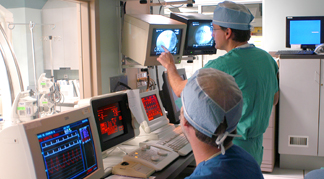- Electrocardiogram (ECG). An electrocardiogram records electrical signals as they travel through your heart. An ECG can often reveal evidence of a previous heart attack or one that’s in progress. In other cases, Holter monitoring may be recommended. With this type of ECG, you wear a portable monitor for 24 hours as you go about your normal activities. Certain abnormalities may indicate inadequate blood flow to your heart.
- Echocardiogram. An echocardiogram uses sound waves to produce images of your heart. During an echocardiogram, your doctor can determine whether all parts of the heart wall are contributing normally to your heart’s pumping activity. Parts that move weakly may have been damaged during a heart attack or be receiving too little oxygen. This may indicate coronary artery disease or various other conditions.
- Stress test. If your signs and symptoms occur most often during exercise, your doctor may ask you to walk on a treadmill or ride a stationary bike during an ECG. This is known as an exercise stress test. In other cases, medication to stimulate your heart may be used instead of exercise.Some stress tests are done using an echocardiogram. These are known as stress echos. For example, your doctor may do an ultrasound before and after you exercise on a treadmill or bike. Or your doctor may use medication to stimulate your heart during an echocardiogram.Another stress test known as a nuclear stress test helps measure blood flow to your heart muscle at rest and during stress. It’s similar to a routine exercise stress test but with images in addition to an ECG. Trace amounts of radioactive material — such as thallium or a compound known as sestamibi (Cardiolite) — are injected into your bloodstream. Special cameras can detect areas in your heart that receive less blood flow.
- CT angiography for CAD. CT is now available to diagnose coronary artery disease.
- Cardiac MRI. Cardiac MRI uses a computer to create images of your heart as it’s beating, producing both still and moving pictures of your heart and major blood vessels.
- Cardiac catheterization. To view blood flow through your heart, your doctor may inject a special dye into your arteries (intravenously). This is known as an angiogram.

